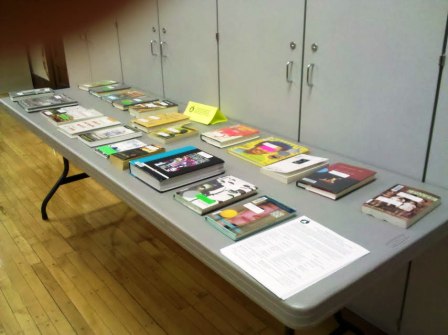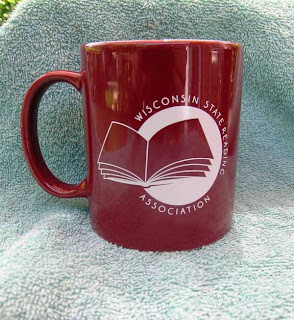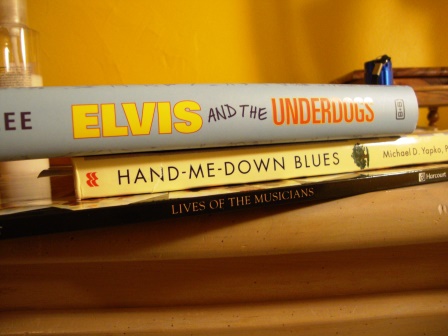This mug usually sits on my desk at school. Every time I sip from it or just read it, the mug reminds me of how important my job can be. That’s a lot to ask of one simple coffee mug. Bring on the coffeepot; a strong blend would be appropriate!
Tag Archives: So many books: So little time
Bookstores and Book Spine Poetry
I’m spreading the word again: the word of book spine poetry. This time, it’s on the national blog from my employer. Please feel free (and feel encouraged) to share, like, pin, or simply enjoy the post. We had a good time making it.
Meanwhile, I picked up a book or two last night. Bookstores are dangerous. I have to stay focused. Walk in, walk out, and only buy what’s on my list. Do not stray from the center aisle. Don’t go near that sale table. Get what I need, then check out, and then leave.
I was doing rather well, I thought. Picked up the two books in the humor section, then headed to the children’s section and asked for the book by title and author. That led me quickly to the shelf with no danger of browsing on the way. Then I headed out to the registers, and I found this.
The cashier said she’d never set foot on the other side of the counter. She had no idea how much fun some other employee had setting this up.
Now, readers, I suppose you’re wondering. Did I make it? Did I get to the exit doors without buying something on impulse?
Almost.
I bought bookmarks.
Thanksgiving in April
Signs that I am a literary type —
Every time the nurses asked me the standard question, “What month is it?” I was tempted to say, “April is the cruelest month” instead of simply “April”. I did find myself saying, “Still April for a few more days!”
My dear darling husband “Chuck” suggested that pre-surgery, maybe I was like the Scarecrow in The Wizard of Oz. I had a brain, but it wasn’t running on all cylinders. Now that the carotid artery is unblocked, who knows what ideas might surface!
I spent one morning chatting with the nurse about our favorite authors. It all started when she noticed I’d brought my Kindle with me. I recommended a book for her, and she recommended one for me.
The day nurse showed the tender spot on my abdomen to the night nurse and warned her that I was very, very sensitive there, but the pressure had gone down significantly since I moved onto the ward. I pointed toward the ceiling and told her, “See the footprints? Those are mine.” The pain was bad, folks. No way around it. Relief, however, was on the way.
Chuck and I shared a funny with the night nurse when she asked me to close my eyes and touch my nose. M*A*S*H fans to the end, we giggled a little about a recent episode when Blake was treating Radar and asked him to close his eyes and “…touch the old nose.” Radar, literal as always, closed his eyes and reached out to touch not his own nose, but the Lieutenant Colonel’s.
On a more serious note, people, I’m very thankful for many things. Most of all, I’m thankful that I didn’t know the extent of the blockage in my carotid artery until after the scan and surgery were completed. I freaked out a little (okay, I admit it, a lot) when I got the news. Now that it’s over, I can just feel relieved. Very, very relieved.
Decisions, decisions.
- Should I make a single batch of banana bread or a double?
- Double, of course. We have enough bananas. Do you even need to ask?
- It’s raining outside. Can I accomplish any garden tasks in the rain?
- No, silly. Get the laundry done and play in the kitchen, instead. Did I hear someone say banana bread?
- Big headline in the newspaper about a state level politician reaching his tipping point. What’s the book I’m currently reading?
- The Tipping Point, of course. It’s on my table in the den.
- “Mom, you have banana bread in the oven. Why are you making bread in the bread machine?”
- Why not? That wasn’t a good enough answer, apparently. The real answer came from Chuck: “It’s raining outside, so Mom can’t work in the garden. She needs to use her energy in the kitchen instead.” ‘Tis true. Very true.
- I had a message from the Clinic That Shall Not Be Named with a subject line How Are you Doing? and the name of my family doc listed as “from”. How am I doing?
- Well, Clinic, I was misled for a moment and thought someone actually cared to follow up with me. But when a message is extremely generic and is signed “The Clinic Physicians”? Somehow, I don’t feel obligated to answer.
- So, Daisy, what was this generic message from the Clinic That Shall Not Be Named?
- Here’s the actual text:
Thank you for your recent visit. Because we care about you, please take a moment to tell us how you are doing. If you were prescribed any medications, please let us know how they are working or if you have any financial issues affording them.
Do you have any other questions since your last visit?
Thank you for your time.
- How tacky can this clinic get?
- Don’t answer that. I don’t want to know.
Book Spine Poetry – the sequel
When stuck inside on a day that should be spring, books keep me busy. Reading, updating my account at paperback swap dot com, and my latest, book spine poetry.
Maybe these should really post on A Mother’s Garden of Verses. I think I’ll double post a few book spine poems. Readers, it’s time to “write” your own. What kind of book titles can you assemble into a poem?
Book Title Poetry
Call it Title Poems or call it Book Binding Poetry, and you’ll still have fun, whatever you call it. The result won’t be a run-on sentence like mine, either.
My dear darling husband and Public Radio junkie heard the concept on the show “Away With Words.” He walked over to my dresser and saw these three titles.
You can guess what happened next. Some attempts were more, shall we say, poetic than others.
I have a sneaking suspicion this poetry genre will happen again in and around my shelves. Readers, which book binding poem strikes you today?
Read Across America
(as seen on Facebook)
In my life, I’d use a different turn of phrase. I’d most likely substitute tools for weapons. But in Malala’s life, the act of seeking an education was radical and law breaking. She saw books and learning as tools, but also as weapons: weapons to fight the good fight, tools to achieve great things.
The pen is mightier than the sword- and so is the desktop publisher. What remains is the reader. If the reader is taught to think and analyze, to seek understanding, then the book itself can be powerful.
Restlessness and Spring Fever – kinda
Entering Week 4 of my convalescence, I am restless. I have filled my time watching a lot of the Winter Olympics, reading books, and forcing myself to sit on the couch and rest. My yard sign for the local school referendum is buried in snow. I managed to bring in a few planting containers and tools, but the majority are out of reach behind yet another snowbank.
On my list:
- Vote.
- School referendum
- Primary election for City Council to represent my ward
- See Eye Doctor.
- Check left retina. Vision is nearly back to normal, I think. I hope.
- Check right retina. Now that I’ve have the left retina detach itself from its moorings, there’s a 3 in 4 chance the same will happen to the right. I sense floaters and a small blind spot on the right. Are these the same astigmatisms of old? Or is this a sign of more trouble to come? Maybe it’s a good thing I still have two weeks of sick leave ahead of me.
When those two tasks are done, I’m probably going to hit the couch for a nap – no urging needed.
Making the Book List – grades 7 and 8
I started reading suggested books for grades 7 and 8 feeling somewhat embarrassed at how many I hadn’t read, I attacked one I had on my Kindle: The Wonderful Wizard of Oz. The first of L. Frank Baum’s Wizard of Oz collection, it was an easy read. The language of the early 20th century (the book was published in 1900) might make today’s readers giggle a little and some weak readers might misunderstand parts of the plot. Those who grew up watching the 1939 movie might wonder why there are differences. Students lucky enough to know the stage show, which premiered on Broadway in 1902, will recognize parts of the show that do not show up in the book, such as the Tin Woodman’s back story.
I liked the book well enough. In the big picture, the Wizard’s collection has grown in ways Baum couldn’t have predicted. Judy Garland’s fame, the 1939 movie production in color, and a century later, the phenomenon of the book Wicked and its Broadway version.
Baum also has a note in the preface cautioning readers not to think too much while they read. He states that he wrote the book collection for entertainment, and entertainment only. Truth or little white lie, I don’t know. I remember a high school history teacher talking about symbolism in the collection, such as the Scarecrow representing the farmers and the Tin Man in the place of the Industrial Revolution.
I wish I knew a little more about the middle school English Language Arts curriculum. When I reviewed the freshman book list a few years ago, I had at least a general idea of a theme: “the concept of the individual as well as interpersonal relationships.” For grades 7 and 8, the administrators did not provide that information. They only provided a list of books.
Knowing the reasoning behind the choices makes a big difference. In fact, whether the Wizard was meant to entertain or to symbolize makes less of a difference than why students will read it. When I taught 6th grade, our goals included both learning to read and reading to learn. We didn’t have an overarching theme, but we had a goal: that our students would learn to read, think, analyze, compare, and understand at high levels. We chose books according to the students’ reading levels.
In conclusion, The Wonderful Wizard of Oz is a nice piece of Americana, a classic story that grew into much more. I enjoyed it. I’m keeping it on my Kindle and reading the other parts of L. Frank Baum’s original later – when I can get it away from Chuck’s fascination with Kindle’s word games.
Making the list – the book list
Two years ago – February of 2012, in fact – I posted this picture.

A new table has turned up in our hallway. I happened to be in the building for a different reason (I’m on sick leave recovering from surgery, remember?) so my chauffeur (Petunia) and I stopped by the table to pick up lists. I do have time for reading as I heal, so I might look into getting a few of the titles I haven’t yet read.
But wow. There are a lot of books that I haven’t read on the list . On the list for grades 7-8, I’ve read five out of the ten titles. In those for grade 9 and 10, I’ve read one, exactly one, out of the suggested sixteen. In fact, I read it and reviewed it and found it fascinating. Life as We Knew It by Susan Beth Pfeffer — here’s the review.
None of the previously listed books are here, so I’m guessing those already approved might remain part of the curriculum. I’ll start with those I know, and then see what I can find on Paperback Swap and at the downtown library.
The Wonderful Wizard of Oz is on my Kindle. Now I have motivation to read it.
Where the Red Fern Grows by Wilson Rawls is a classic piece of literature in many categories. I remember a gifted sixth grade reader asking to borrow it from my shelf, and then asking a friend to reminisce. “Remember when we were in third grade and Mrs. Sippi couldn’t finish reading this aloud because she cried?” Red Fern belongs on the “Read it with a box of tissues” shelf with Stone Fox and Walk Two Moons. The story is wonderful, and the setting is just foreign enough to my local kiddos that it will keep their attention.
The Hunger Games by Suzanne Collins is a popular favorite. Personally, I might leave this out of books to read in class because so many young people are picking up the trilogy and seeing the movies.
Hoot by Carl Hiaasen and Holes by Louis Sachar have been “listed” for years. Both are excellent, and fairly easy reads for grades 7 and 8. Hoot shows a typical Hiaasen environmental bias and is a lot of fun to follow. I’ve read this aloud to fourth graders (who hadn’t seen the movie) and it was a hit. Holes? Brilliant. Louis Sachar braids present with historical and a hint of supernatural and somehow it all comes together seamlessly in the end. Fans of Holes might also enjoy Small Steps, also by Sachar, which follows two of the inmates from Holes into their life after Camp Green Lake. I read Small Steps to my 6th graders, most of whom knew Holes, and they took to it like shovels to snow. Um, poor analogy there, sorry.
Lemony Snicket’s opening salvo in his Series of Unfortunate Events also appears here, and my reaction is similar to The Hunger Games in that so many students have already read this and its many sequels. Lemony Snicket has a lot of fun with language, and that leads to a humorous telling of otherwise disastrous tales. The Bad Beginning is short and the plot is simple, leading to a quick and relatively easy read. Since this is the first in a lengthy series, it offers a chance to get readers interested in the characters and the story structure and read more of the same. That would be the strongest reason for me to assign The Bad Beginning for students to read.
Now I’ll dive into the rest of the list and see what I can swap, download, or check out for the remainder of my sick leave. Readers, let me know. Leave a comment. Have you read any of those I discussed or any of the rest of the list here?
Between Shades of Gray by Ruta Sepetys
The Boy in Striped Pajamas by John Boyne
The Boy on the Wooden Box by Leon Leyson
Ender’s Game by Orson Scott Card
Four Perfect Pebbles: A Holocaust Story by Lila & Lazan Pearl and Marion Blumenthal
The Invention of Hugo Cabret by Brian Selznick
Stormbreaker by Anthony Horowitz
The Thief Lord by Cornelia Funke and Christian Birmingham
That’s the list for grades 7 & 8. I’ll share the rest with you later.












